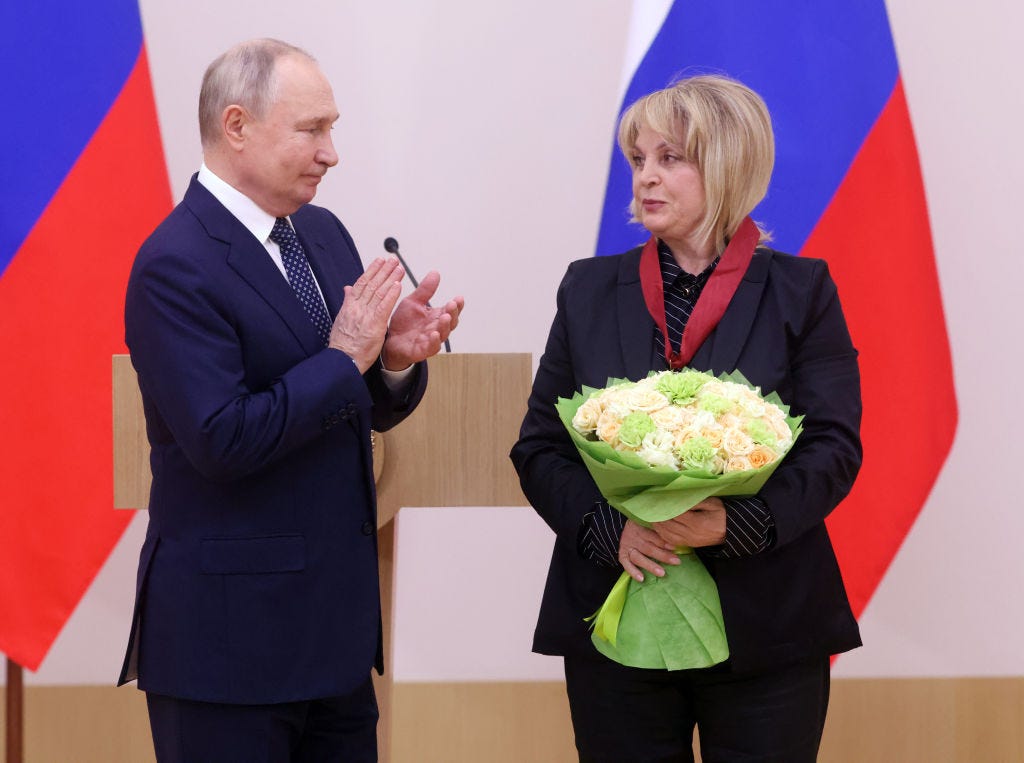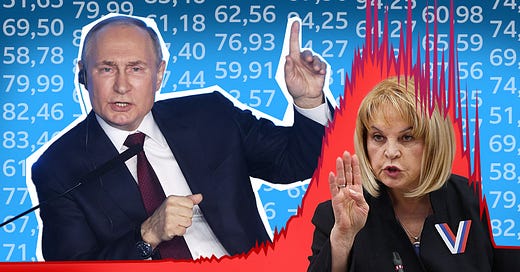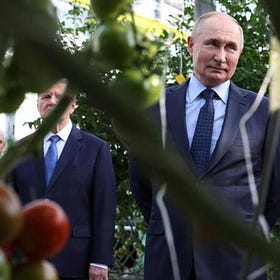Historically unprecedented fraud: what maths reveals about the true voting figures for Vladimir Putin
A technique developed by a Russian physicist demonstrates the lengths loyal officials went to this year to massage the ballot in favour of the ruling candidate.
By Natalia Zotova.
After every vote in Russia, electoral analysts search for anomalies in the turnout figures or in the distribution of ballots cast – because falsification can be mathematically demonstrated. This time round, the data analysis from polling stations suggests signs of unheard of vote tampering.
In this video from a polling station in St. Petersburg, a woman staggers into view with a bag full of ballot papers in her arms. She waddles across the floor on her knees – presumably to keep a low profile and to avoid being seen. She and a colleague begin stuffing piles of voting slips into the ballot box. A policeman appears to notice, but turns his back and walks off instead of intervening.
After they’ve completed their work, the first woman grabs hold of the box and tips it back onto her now recumbent body, as if engaging in a bizarre yoga move. Together with her colleague, they wrestle with the ballot box, shaking it to try to make the papers look more naturally piled up inside.
The events here were caught on camera and leaked. There may have been many more videos of such incidents had the authorities not decided to restrict access to CCTV recordings. In 2012, for example, they were still in the public domain.
‘Golos’ – or ‘Voice’ – is Russia’s only independent election watchdog. It said the presidential vote was riddled with violations and goes down in history as the most fraudulent ever. (The organisation was declared a ‘foreign agent’ in 2013 and one of its leaders is in pre-trial detention.)
Nothing could be further from the truth, according to the chair of the Central Electoral Commission Ella Pamfilova – “There have been no complaints or violations,” she informed journalists.
Very few violations were captured by observers, who were in effect banned from this election. But here’s where mathematics comes to the rescue – and it suggests fraud on a serious scale.

Voting data and comet tails
The physicist Sergei Shpilkin devised a method in the early 2010s for distinguishing the quantity of ‘honest’ votes cast from falsified ones. It uses open data from polling station results the Central Electoral Commission publishes, which Shpilkin compared to a Gaussian curve, or the normal distribution characteristic of random processes. Like honest voting, for example.
Described in a 2D figure, the distribution of turnout and result statistics from every polling station should resemble a single, symmetrical, rounded form. The 2024 vote was the first in which the normal distribution of votes, as analysed by the Shpilkin method, was in effect wiped out. Falsification raised both the turnout and final percentage of votes for the ruling candidate. If you plot the turnout on one axis and votes for Putin on the other, you don’t get a rounded shape but a ‘comet tail’ instead.
‘Novaya Gazeta Europe’ calculated that the ‘honest’ shape that represented voting in the last election in 2018 virtually disappeared in 41 regions across Russia this time round. And in five other regions, according to their analysis, more than a third of the votes for Putin were fake and simply stuffed into the ballot box.
After the 2018 election, Central Electoral Commission members objected to gauging Russian presidential polls against a Gaussian curve, saying the method wasn’t appropriate to voting. Pamfilova claimed that European elections would also be found wanting by such a method. But journalists from the ‘Meduza’ news organisation ran an analysis on voting in Germany and France – and the Gaussian curve turned out pretty well in both countries.
The ‘Saw of Churov’ turns into a hedgehog
Back in 2011, outraged by fraud at that year’s parliamentary elections, people began to joke about the ‘Saw of Churov,’ named after the then head of the Central Electoral Commission, Vladimir Churov. The curve of normally distributed votes ought to resemble a bell. In 2011, the graph for turnout and voting was characterised by sharp peaks and troughs resembling the teeth of a saw. The reason is that when a bureaucrat falsifies a vote, they tend to enter nice round numbers, not tenths or hundredth fractions of a percent, which causes the spikes. Statisticians note that creating smooth ‘natural’ curves by artificial means is impossible.
“The saw has mutated into a hedgehog,” notes electoral analyst Ivan Shukshin. He analysed data from this year’s presidential election using the Shpilkin method – and found the anomalous peaks to be far higher and more pronounced than even in 2018. There is not much of a bell shape in evidence for 2024.
How many ballots were faked?
The electoral expert Shukshin reckons his analysis shows there were 22 million anomalous paper votes cast for Putin. But that doesn’t of course include electronic voting: the digital system is entirely impenetrable to assessment, though it is known that it was generally unfree, and that state employees were compelled to use it.
The journalists from ‘Novaya Gazeta Europe’ came to the same conclusion: using Shpilkin’s method on polling station data, they calculated that 22 million votes were stolen. They reckon the true percentage in favour of Putin at this election was more like 57%. Polling station staff may not have stuffed quite that many ballots into the box, but may simply have transferred votes for opposition candidates over to the pile of papers for Putin. The Shpilkin method cannot account for that.
Did the results for other candidates change as well?
Analysts believe the result for the ‘New People’ party candidate, Vladislav Davankov, was undercounted. Davankov was the choice of those who were unhappy with the government and wanted a protest vote: so he was deliberately put back to third place. According to the data from the Central Electoral Commission website, in those areas with an apparently realistic turnout figure, Davankov came second: in front of Leonid Slutsky from the right-wing Liberal-Democrats and Nikolai Kharitonov of the Communists Party. But in those places with a fake 80% turnout, he comes behind the communist.
“Up to a 75% turnout figure, Davankov’s curve is about twice as high as the other opposition candidates. And this is his real result, about 11% of the votes of Russians,” says Shukshin.
Where was the most fraud committed?
Independent election observers have long talked about ‘electoral sultanates’ on the map of Russia — regions where election results are traditionally drawn up in advance, and regions that have a different electoral culture, where there has been a strong observer presence and people have gained access to local polling stations to ensure an honest vote count.
In this year’s presidential elections, there were significantly fewer regions where votes were counted more or less honestly. ‘Novaya Gazeta Europe’ identified 13 regions where fake votes for Putin totalled less than 10% of the final figure. “In the last presidential elections in 2018, there were three times more ‘honest’ regions (41), and in 2000 there were four times more (59),” the journalists calculated.
Mathematical methods are not capable of checking all kinds of fraud. For example, the Shpilkin method of analysis cannot measure for those whose bosses at work forced them to vote ‘for the right guy’. It also doesn’t take into account the fact that even mildly critical opposition figures were barred from running in the elections in the first place.
BBC is blocked in Russia. We’ve attached the story in Russian as a pdf file for readers there.
Read this story in Russian here.
English version edited by Chris Booth.
Previously…
Tomatoes, a short history of Belgium, and ‘beautiful ladies': on the campaign trail with Vladimir Putin
Voting has started in an election that will gift the Russian president at least another six years in the Kremlin. BBC Russian takes a look at Putin’s recent ‘meet and greets’ with the public.






